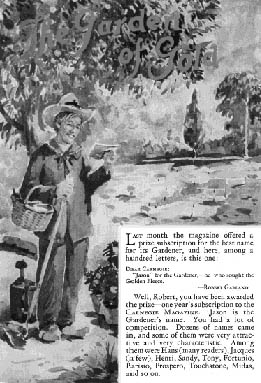
In 1927 Samuel Harden Church, nearly 70 years old and the president of Carnegie
Institute, purportedly announced to his secretary, "We've got to have a magazine!"
By April of that year the first issue of "Carnegie Magazine, the Bulletin of
Carnegie Institute," appeared.
As the last of the original trustees to survive from Andrew Carnegie's time, Church (1858-1943) saw the mission of Carnegie Institute in the personal and global perspective that Carnegie took. Thus Church wrote personal reviews of national economic policy, and invited world leaders to make state-of-the-world addresses at the annual Founder Patron's Day. He sent his fledgling bulletin to Very Important Persons, in keeping with the founder's idea that managing great affairs of state began with personal diplomacy. Thus three issues after the bulletin began, he noted with pride that it was being mailed to "the President of the United States, the Cabinet, the Supreme Court, all the United States Ambassadors and Ministers Abroad, all the foreign Ambassadors and Ministers at Washington, the heads of all the principal institutions of art, science and learning throughout the world, many distinguished citizens in various parts of the United States, a choice number of newspapers and magazines, and some 1,300 men and women of Pittsburgh."
As president and chief fund-raiser, Church became a literary guide through the monthly "Garden of Gold," a column in which he asked readers to plant financial seeds, metaphorically, in the "garden" of Carnegie Institute, Library, or nearby Carnegie Institute of Technology-all three institutions then being governed by the same board. He held a write-in competition to name his metaphorical Gardener who would tend the garden-and the name "Jason...he who sought the Golden Fleece" was selected. The Gardener's wife was the faithful Penelope, who was given to utterances such as, "Why dear Jason, this ought to be one of your most prosperous days," and sometimes they were. Jason labored in the garden attired in his Golden Fleece. On certain days Jason's eyes filled with tears of gratitude as generous friends such as George H.Clapp would show up, hail him with cheery greetings, and make gifts, wrapped in tissue paper, of funds to use for the museums' endowment. Sometimes Church ran pictures of the Gardener's friends, who included such notable citizens as Childs Frick, Mrs. Taylor-Allderdice, Herbert DuPuy, Andrew Mellon and Richard B. Mellon.
A tireless worker himself, Church used his little magazine, published 10 times
per year, to promote Carnegie's Institute and Library. On October 11, 1943, three
days before the 46th annual Founder's Day, Church was stricken at his desk in the
midst of busy preparations, and died soon after. The death of this classic Victorian
administrator illustrated Tennyson's thought in the poem Ulysses: "How dull it
is to pause, to make
an end,/To rust unburnished, not to shine in use, as tho
to breathe were life!"
But his magazine continued as he would have wanted it to. For decades it reflected-and still does-the close intellectual and cultural links between the museums, public library and universities in Oakland. Through seven decades Carnegie Magazine has become a record of cultural activities in art, science, literature and music, as Pittsburgh's Palace of Culture expanded as a center for exhibitions, concerts, lectures and performances. Visiting the museums has always been a defining experience for Pittsburghers. Seeing the Carnegie Internationals, or Dinosaur Hall, have been rites of passage into the worlds of art and natural history for generations of people.
Few museums have magazines, and only one cultural complex-the Smithsonian Institution-is tied to as many different subjects under one institutional umbrella. The recent Library of Congress periodical, Civilization, is another rare magazine entry in the pluralistic field of arts and sciences. The reason Carnegie Magazine has been unique for so long is that Carnegie Museums and Library have been unique from the start. The local audience often seems surprised by this. But a moment's inquiry (In what other city can you find a public library, art museum, natural history museum, music hall, science center and single-artist museum-the Warhol-blended into one cultural pie for public consumption?) always proves the point. Carnegie Museums and Library of Pittsburgh are an American original. An institution like the Smithsonian draws upon federal money to support different facilities that are free to all citizens, and is in a national category by itself.
Carnegie Magazine evolved through 70 years into a bimonthly periodical, and with
its growing need to cover the many activities of its institutional family it is thus
a unique
magazine. It is also, despite its local appeal, not at all provincial,
just as the museums' major exhibitions are not Pittsburgh-specific. Consider a recent
group such as Designing the Modern World (Museum of Art), Wildlife Paintings of Carl
Brenders (Museum of Natural History), Edward Wallowitch: Photographs (The Andy Warhol
Museum), or Robotics (Carnegie Science Center). All of these topics are of national
interest, and the robotics exhibit was developed in Pittsburgh and will travel to
other institutions.
Recent changes in the Carnegie Magazine have included new columns such as Kitchen Theater, Book Reviews, Research and Carnegie Skywatch, and more changes are being planned. President Church would probably be very pleased that his little magazine has changed and grown for 70 years in the dangerous world of periodicals, where the fatality rate is high. He would also be proud that the magazine he himself planted in his metaphorical Garden is now a sturdy oak, deserving of a few more tears of joy from the eyes of Jason the Gardener, who has been working ceaselessly to nurture such plants for the benefit of Pittsburgh.
-R. Jay Gangewere